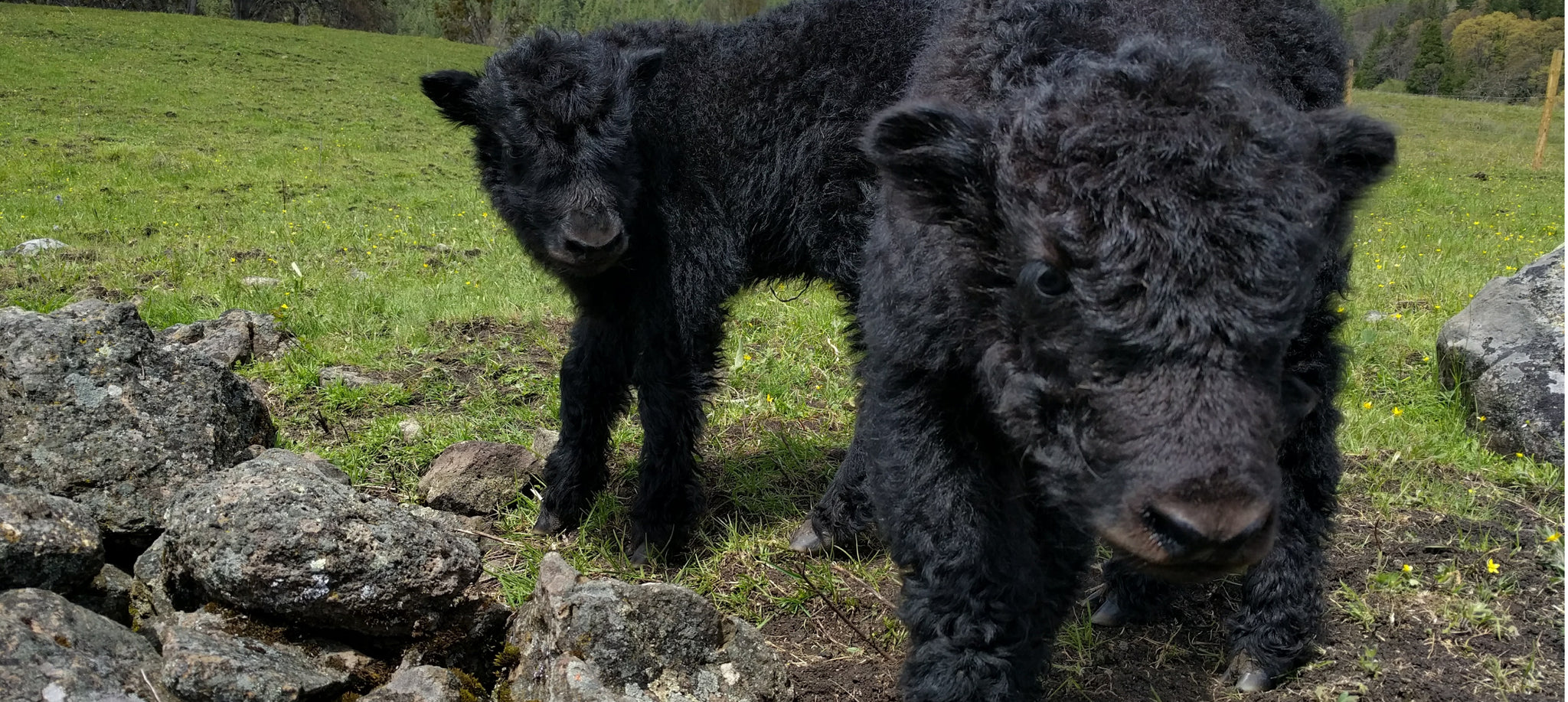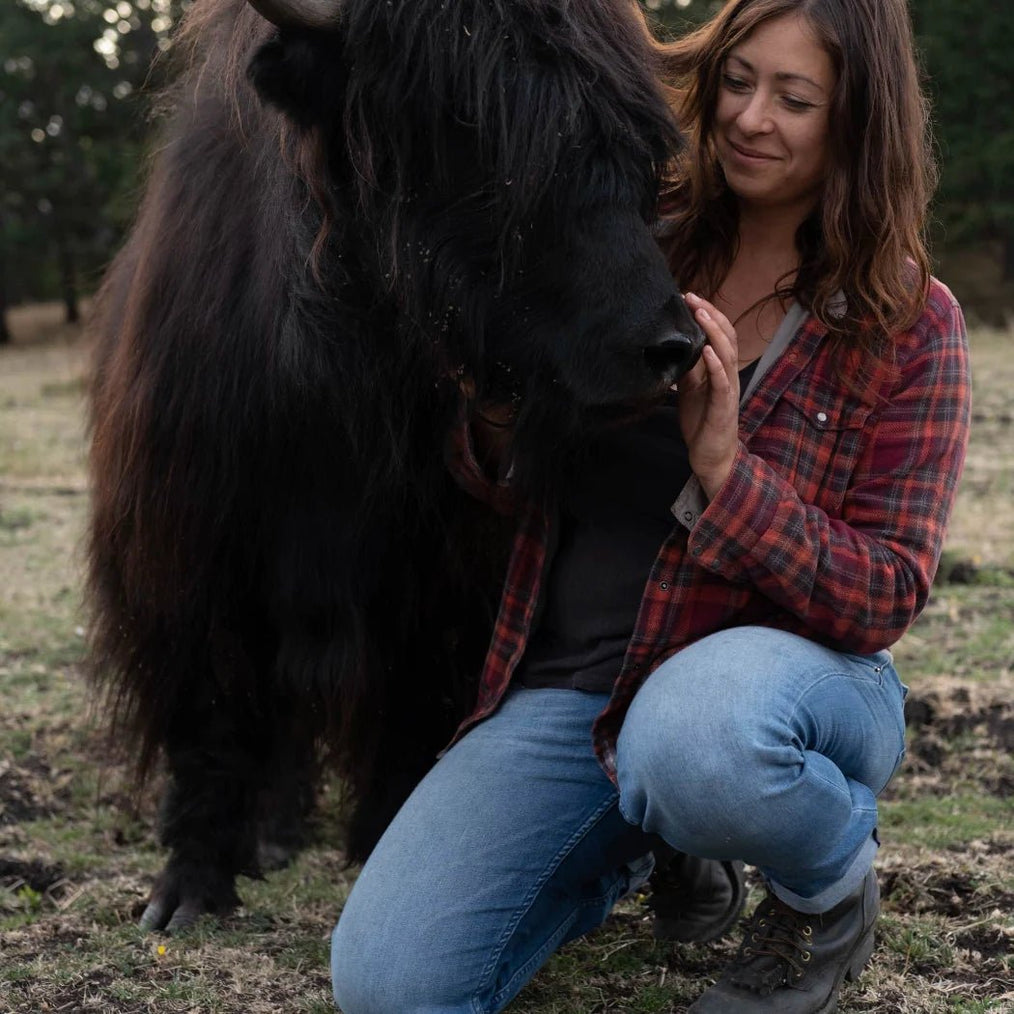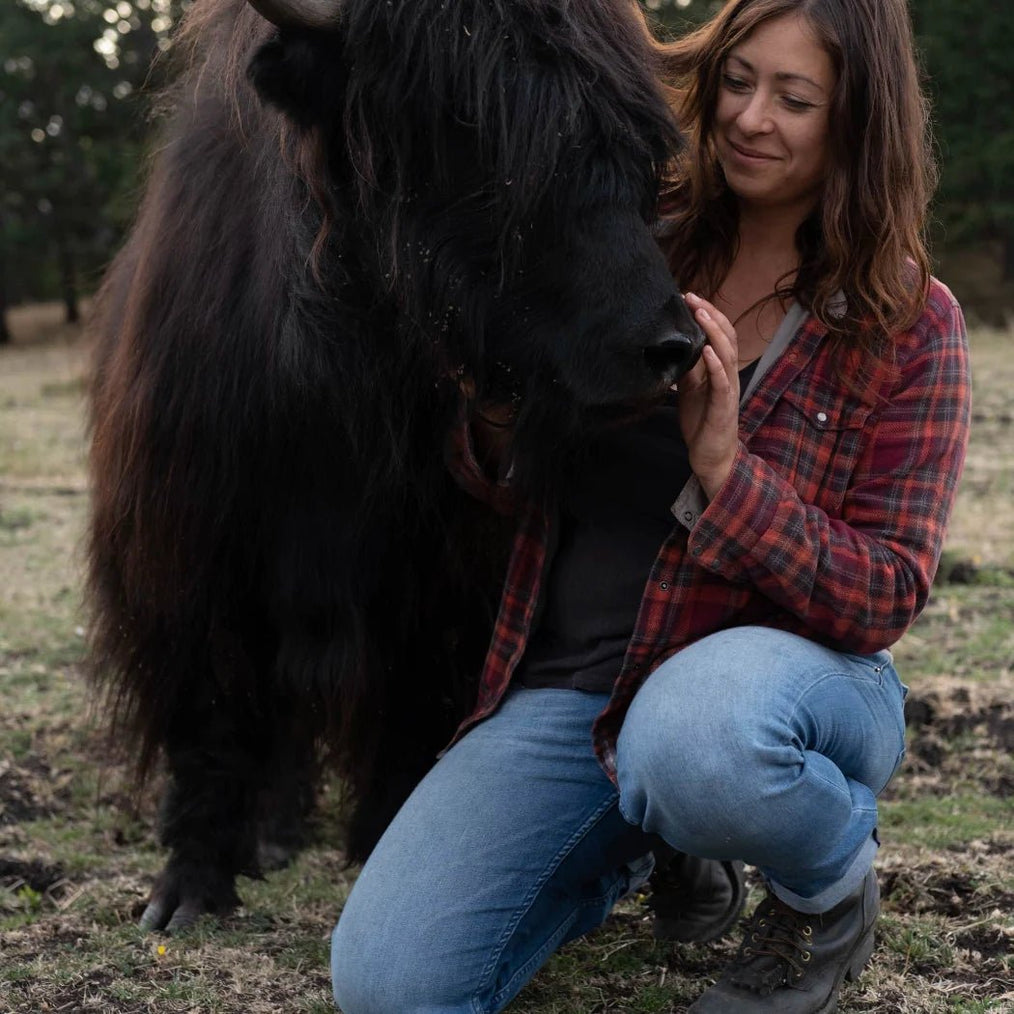FEED
Yaks require proper nutrition to perform well as both meat producers and fiber pets. While they are traditionally from sparse-forage regions of the Himalayas, the adaptations they have there are different from what we see and expect out of them in the US. For example, in Asia, yak cows calve every other year and raise their calf for around 16 months. This means they have lower nutritional demands annually and match the available nutrition on the landscape for maintaining their weight and growing a calf.
In North America, we generally raise our yak cows to calve annually, typically nursing their offspring for 6 months. While they are completely capable of doing this, it is important to have a proper nutritional program complete with good food and minerals. This ensures that the cows maintain a proper body score throughout gestation, calving, lactation and rebreeding. And the calves have a good growth trajectory, to be weaned between 6 and 7 months. It is similarly important for bulls to maintain good virility and ability to breed cows well. And for meat animals, optimal nutrition yields the best growth rates and, combined with good meat genetics, will ensure best yield and profitability of a meat program.
Fiber production is also influenced by nutrition, in addition to winter temperature. One of the first signs of deficiency is often a dull coat. Necessary supplemental winter feed depends on your location and environment. However, there are costs associated with raising yaks no matter the location. Yaks are a relatively new species in our Western world. Therefore, there is not a lot of data thus far on exactly what makes a good feed and mineral program that is scientifically verified. Scientific studies are underway, and we look forward to updating you as studies are completed and information is released.
The following is information based on our experience raising yaks and in speaking with other ranchers across the country. This should be used in conjunction with your own experience as you work with these animals in your particular area.
In the growing season, yaks are often fine grazing on summer forage. The quality of the pastures will determine if supplemental feed is necessary at this time. They need minerals available to them year-round, as discussed below. While we have seen some operations with healthy looking animals that are fed lower quality hay, it is generally regarded that high quality feed yields quality results. We feed free-choice fine stemmed organic alfalfa in the winter, interspersed with grass hay.
Percentages between the two can vary depending on weather, gestation period in the cows and by monitoring their performance through periodically weighing the yaks. In general, choose a good quality hay source with higher protein for optimal growth. Grass hay can generally range from 7% to 9% protein. Alfalfa can start at 15% and higher quality dairy alfalfa can be 25% or more. We like to balance their diet in the winter months to be around 13% protein. We have fed only alfalfa at around 24% protein, and it can get “hot” in the winter after months of eating such a rich diet. Most animals do fine, but some had loose stool and needed something more bland for their rumen. We have also fed 8% grass hay for a duration of time.
The results were that they were mostly able to maintain their weights, but they did not gain weight significantly while being pregnant, and some weights of meat steers actually dropped from what they had gained during summer months. For optimal productivity, quality feed saves money in the long run, by not dropping summer weight and gaining through winter, in both cows and meat animals. Particularly in the last trimester before calving, it is important to have access to quality nutrition.

MINERALS
While there is no data on this yet, there are some general recommendations that most breeders share. In selenium-deficient areas of the country like here in the Pacific Northwest, a selenium salt block or loose minerals should be provided at all times, preferably near a water source. These can usually be acquired at farm and ranch supply stores.
Yaks also have higher copper needs than other bovines. Why and how much is still in question. Most mineral blocks do not have optimal levels to offer free choice, which should be around 300ppm copper. Some ranchers use loose minerals, and others use blocks. Loose minerals can be challenging in areas with high rainfall, and they need to be under cover to stay dry.
We have tried a number of products and currently use Redmond’s Bison 90 loose minerals. They are naturally occurring, but with added molasses for taste. There is a Bison 30 with less selenium if your area is not deficient. Some ranchers have success with Vitalix tubs. There are other products on the market that have higher copper levels. Talk to your vet and see if they have any recommendations if these options do not suit your needs.
Getting yaks to eat any minerals is the hard part. It is reputed that herders in Asia have the same issue. Maybe the yaks know something we don’t. However, mineral deficiency can cause real problems in your herd and even deaths. So, finding a way for them to take their vitamins is critical. Some ranchers have reported that they will see yaks licking the salts for a while, then not for weeks. So, don’t be discouraged if you don’t see the yaks on the salt daily.
They usually know what they need and ingest the right amount. However, if serious mineral deficiencies are evident in your herd, you may want to try using something like Multimin injection. Just start slow and don’t do too much. If the yaks are emaciated, follow the warning on the label and do not use it until body weight goes up. Yaks are more sensitive than cows in certain ways, and I always err on the side of caution with medications.

CALCULATING WINTER FEED
Yaks can eat up to 3% of their body weight a day in colder weather. Some ranchers calculate between 2% and 3%, but to ensure enough available hay until the next growing season, I like to calculate at 3.5% and add some more in final calculations just to be safe. So, a 600 lb cow at 3% body weight would consume 18 lbs of hay a day. A 1300 lb bull would consume 39 lbs per day.
When cows are close to calving, and weanlings to yearlings are growing rapidly, I believe they can consume more than 3%. So a safe calculation across the board may be 3.5% body weight. I make sure I have or can get an additional 10% of the total winter feed requirements before the next growing season. Depending on the severity and duration of the winter, it is always good to have extra hay. It is a valuable commodity in early spring before the next season’s cutting, and if you have a large surplus it can be sold.
The manner in which hay is fed will also determine the total required amount. In rainy climates or those that do not have permanently frozen ground during winter months, up to 30% losses can occur from waste. Feed can get worked into the ground, saturated from rainfall or melting snow, and lost as a feed source. It is vital to the bottom line to determine feeding techniques that are designed to minimize waste.



